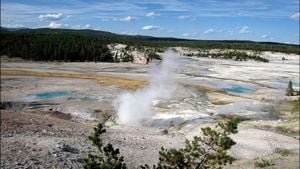Nasa's Boeing Starliner mission has faced significant delays, leading to unexpected complications for two astronauts who were supposed to return to Earth within days.
Now, they find themselves potentially stranded aboard the International Space Station (ISS) for several months due to malfunctions with their spacecraft.
The astronauts, Butch Wilmore and Suni Williams, launched to the ISS on June 5, 2024, onboard Starliner.
This mission marked the first crewed flight for the Starliner, which had been years in the making and was highly anticipated as part of NASA's commercial crew program.
Initially, Wilmore and Williams’s mission was planned to last just eight days, allowing them to conduct important research aboard the ISS.
Recent technical issues, including helium leaks and failing thrusters, have raised serious safety concerns about their return flight.
NASA leaders updated the media on the situation, expressing their hopes to assess whether Starliner could safely bring the astronauts back.
The astronauts are reportedly managing well, keeping busy with their research and living conditions on the ISS.
During recent communications, NASA officials assured the public of their well-being, noting, "Butch and Suni are well engaged on the space station" based on comments from NASA's associate administrator for space operations, Ken Bowersox.
Despite their positive outlook, prolonged stays like this can have health impacts, raising concerns among researchers.
These health risks include weakened bones and muscles due to the lack of gravitational force.
Without gravity, astronauts' muscles can atrophy, and they risk losing bone density, leading to complications when they eventually return to Earth.
NASA’s Human Research Program has collected extensive data on long-duration space missions, providing insights on how space affects the human body.
Among the documented effects are changes to bone and muscle structure, decreased strength, and alterations to eyesight known as Space-Associate Neuro-ocular Syndrome, which causes changes to the eyeball shape and vision.
Exposure to space radiation is another concern, as it can increase risks of long-term health problems, such as cancer.
Bowersox noted the importance of these risks as NASA plans future missions to the Moon and Mars, emphasizing urgency for solutions.
If the astronauts are not returned by autumn, they might not see Earth until February 2025.
NASA has been considering various options to bring them home, including potential evacuation aboard SpaceX’s Crew Dragon, which would involve complex logistical arrangements.
Such decisions reflect significant challenges facing NASA and Boeing amid recent Starliner failures, which have drawn public and governmental scrutiny.
The option of using SpaceX’s vehicle would likely entail adjustments within existing missions, showing the interconnectedness of agency efforts during critical recovery moments.
Boeing has faced increased pressure to resolve these issues, as Starliner is seen as pivotal to NASA’s future crew transport capabilities to the ISS.
Meanwhile, discussions about crew replacements for the Crew Dragon mission have begun, as NASA plans for potential seats to return Wilmore and Williams.
Notably, the agency's focus on safety remains at the forefront, underscoring NASA’s cautious approach, especially after prior tragedies during the space shuttle program.
Supporting missions to the ISS remains complex, requiring cooperation between multiple agencies and private partners, highlighting the dynamic nature of modern space exploration.
Currently, the pressure rests on both Nasa and Boeing as they navigate their relationship during this turbulent period, marked by technical challenges and communication issues.
The astronauts, meanwhile, are taking each day as it arrives, working hard to maintain their physical and mental health until decisions are finalized.
NASA officials expect to provide updates within weeks, hoping to bring clarity to Wilmore and Williams’s futures aboard the ISS.
Both Nasa and Boeing continue discussions to reconcile their views on the safety of the Starliner, with future missions underlying the importance of resolving these technical failures.



